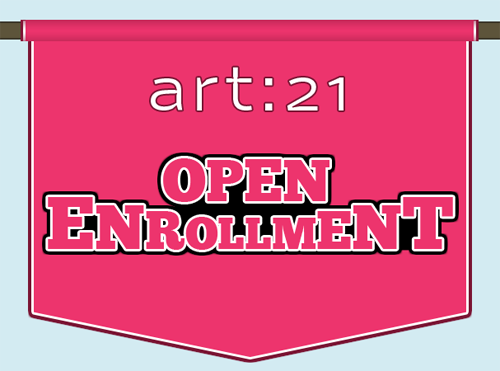
Over the past few decades, “interdisciplinary” has emerged as a popular designation in academic culture, particularly in the arts and humanities. Both as an undergraduate in studio art and as a graduate student in art history, I have felt the lure of this word, which packages a spirit of emancipation inside of institutionally sanctioned language. At the same time, I have always felt uncomfortable with the term since so many divergent activities seem to take place under its name. In an effort to work through some of these concerns, I spoke with Jesse Aron Green, an artist whose practice we might place under the interdisciplinary banner.
Green was born in 1979 in Boston, MA. He received his MFA from UCLA and his BA from Harvard University. His recent exhibitions include: a solo show at Halle14, Leipzig; a solo project in the Oil Tanks at Tate Modern, London; the 2010 Whitney Biennial, Whitney Museum, NY; MOVE, Hayward Gallery, London; CCA Kitakyushu, Japan; and various other gallery and museum exhibitions. His upcoming exhibitions include solo shows at the CCA Ujazdowksi, Warsaw, and the Williams College Museum of Art, Williamstown. He was a Henry Luce Scholar for 2008/09, a Trust for Mutual Understanding/Location One Fellow for 2009/10, and is the Arthur Leavitt Fellow at Williams College for 2010/11.
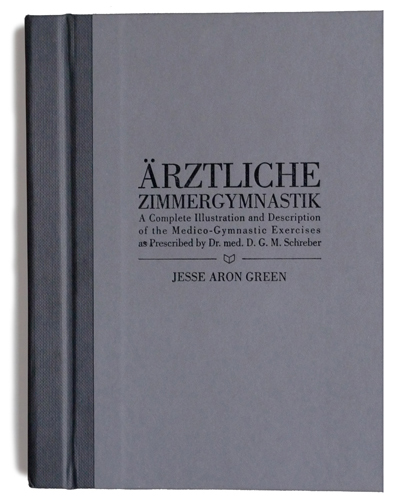
Jesse Aron Green, "Ärztliche Zimmergymnastik," 2010. Artists book. Hand-bound, hard-bound, with 56 french-folded pages. Featuring a reproduction of the complete series of 45 photographs titled "Illustration and Description of the Medico-Gymnastic Exercises," and 122 computer-assisted drawings. Courtesy the artist.
Oliver Wunsch: Can you talk about what it means for you to have an “interdisciplinary” approach to making art (if you accept this characterization)?
Jesse Aron Green: Interdisciplinarity is claimed for many practices and across many fields, which speaks to both the aspirational aspect of working across normative disciplinary boundaries, and the very vagueness of this kind of action or movement. I imagine the term is used liberally in the academy due to the influence of Cultural Studies as it is descends from both post-structuralist theory and post-Marxian critiques of ideology, with their emphasis on understanding social and historical phenomena in relation to both the objects of cultural production and their related subjects (and subjectivities).
However, we’re concerned with the field of art, within which the usage of the term “interdisciplinary” is a bit clearer (i.e. its lineage is clear, if not necessarily its current usage). Modernist practices from the middle of the last century claimed a kind of interdisciplinarity in their production across or between media. One thinks of everything from Black Mountain and the Situationist International to conceptual practices, performance, and so on (including all of preceding practices from earlier in the century to which these later ones claimed lineage, but which may have not made similar claims themselves); that is, all the practices that occupied the space of that which falls between [Michael] Fried’s refined, self-specific arts.
Moving forward, one can point to a range of factors that expanded interdisciplinary practice: technology’s erosion of medium-specificity; the dynamics of cultural stratification; and social movements that critiqued political and cultural institutions (Feminism, Civil Rights, and so on). It’s their legacy, and that of post-structuralism, that leads to a greater critique of forms and frames within the field of art, as well as the eventual theorization of post-modernism and the political imperatives of post-colonialism. It’s at this point, in the 1990s, that interdisciplinary practices are understood as those that borrow processes from other discursive fields: one thinks of both the “semiotic” and the “ethnographic turn,” as they have been called.
What interdisciplinarity means in the field of art at the current moment is unclear to me, except that those who make claims to it seem to do so out of an understanding of its relationship to critique, ideology, and histories of social change, especially as it also inheres a commitment or investment (or what have you) to other disciplinary or intellectual fields within or without the Academy. What the term signifies is even less clear when one tries to account for those who use it more generally: those who point in the direction of historical themes, or those who casually borrow the language of theory from one or another academic field.
None of this, of course, answers your question, which was about my practice.
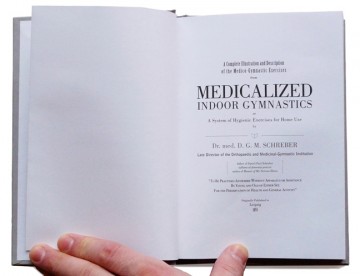
Jesse Aron Green, "Ärztliche Zimmergymnastik," 2010. Artist's book. Hand-bound, hard-bound, with 56 french-folded pages. Featuring a reproduction of the complete series of 45 photographs titled "Illustration and Description of the Medico-Gymnastic Exercises," and 122 computer-assisted drawings. Courtesy the artist.
OW: As I hear you attempt to trace a history of interdisciplinary work, I wonder at what point these practices come to form a discipline themselves.
JAG: The multiplicity of practices today, and the great difference between global, spectacular culture, and local avenues of dispersion of cultural products, point to the relative relevance and irrelevance of this “interdisciplinary” way of working; which is to say that as modes of practice become accepted forms within certain contexts, they may fossilize and become bound to a set of conventions and understandings. The very terrain of that which is considered “interdisciplinary” must then shift, perhaps in context or even in name, to address that which it formerly struggled against. Given the history of the term—its implication of a political engagement with social movements—one should perhaps now speak of these artistic practices as “cultural resistance,” regardless of the bounds of the work, its processes, or its targets.
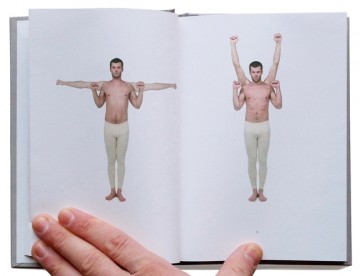
Jesse Aron Green, "Ärztliche Zimmergymnastik," 2010. Artists book. Hand-bound, hard-bound, with 56 french-folded pages. Featuring a reproduction of the complete series of 45 photographs titled "Illustration and Description of the Medico-Gymnastic Exercises," and 122 computer-assisted drawings. Courtesy the artist.
OW: Am I hearing you say that institutional critique has become an institution itself? An interdisciplinary tradition has ossified into the exact thing that it initially opposed?
JAG: A statement of the irrelevance, ossification, or instrumentalization of work that addresses institutional power is like the refrain that painting is dead: it’s a provocation, except in this case it’s one that meets too little resistance. The practice has simply shifted, taken up new residence and new name.
So what does it look like now? I’m not an art historian, so I can only speak to what I brush up against. I think of artists or collectives like Ultra-Red (which started as an AIDS activist sound collective and has shifted to address a range of interrelated social movements, from prison reform to struggles around immigration). Due to the way they engage community groups within the context of the art museum, they’ve been included in exhibitions of “relational” work, like Nicolas Bourriaud’s Tate Triennial. I can’t speak to the way the group may or may not claim allegiance to either Bourriaud’s clan or a tradition of Institutional Critique, or anything else, but it seems that such claims are necessarily secondary to the work. And they, of course, are only one example among many. The Raqs Media Collective, LTTR, Walid Ra’ad’s Atlas Group…
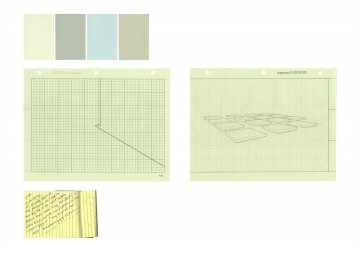
Jesse Aron Green, "das Aufschreibesystem" (4/5; p.202, "Why Do You Not Shit?"). 2010. Archival pigment print. 19x27 in. Courtesy the artist.
OW: In light of this discussion of historical influence, even lineage, how has your educational background shaped your practice?
JAG: Anything I’ve learned has been by way of wanting to sleep with or be parented by the people I look up to; that is, by identification, projection, and desire. And anything I’ve made is by way of overcompensation or overstatement. It’s an undervalued tool, overdoing things.
OW: Overcompensation for what?
JAG: All I mean is that to make work is to aspire, to breathe out a proposition for the future, to give form to one’s imaginings and desires and attempts at understanding. I also mean, in light of your questions about education, that the preoccupations, struggles, and priorities—what have you—of my teachers and mentors may not have been my own, but by acknowledging, via identification or transference, some similarity (or desire to be similar) in my self, I was brought into the knowledge of the forms with which these teachers encountered their preoccupations, struggles and desires. This is how being a student usually works, isn’t it?
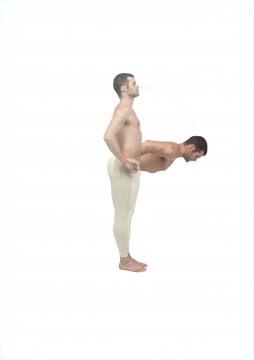
Jesse Aron Green, "Illustration and Description of the Medico-Gymnastic Exercises" (20/45; Bending of the body forward & backward). 2008. Archival pigment print. 30x40 cm. Courtesy of the artist.
OW: You suggest that your aspirations have been tied to particular people. What drew you to particular models or mentors?
JAG: I can only answer that identification happens. Sometimes it happens because the person with whom one identifies is sought out for a specific reason (in the way I followed my interest in feminism to Mary Kelly); or perhaps the person is the only one available; or perhaps identification doesn’t happen until it does, when you suddenly find yourself reflected in the person seated in the chair across from you.
OW: It sounds as if psychoanalytic ideas are part of both your work and your way of thinking. Some of your projects—Ärztliche Zimmergymnastik, for instance—deal directly with the origins of psychoanalysis. Do you find value in psychoanalytic theory beyond addressing the particular moment and context that produced it? Put differently, if we think of your work as historical in nature, does psychoanalytic theory serve as a primary or a secondary source for you?
JAG: You might say that my interest in psychoanalytic theory is overdetermined, or polyvalent, and so this distinction between primary and secondary is not one I would make. In the first case I can say that I see relations in subjective terms (as well as social and economic terms), which informs not only my approach to subject matter, but also the processes by which I make work, including aspects of its construction, display and dispersal. In the second case, I find it necessary and useful to situate both psychoanalytic theory and practice in its various historical or cultural contexts. Often these contexts form the very subject of the work.
Put another way, I might say I’m invested in both psychoanalytic theory for its processes, and for the way it’s been mobilized within the field of art (and other fields).
My motivations behind making Ärztliche Zimmergymnastik were many, but to give an example of my overdetermined interest in psychoanalysis, I’ll focus on one: in light of postminimal practices that engage sexuality and the body, and the relationship to “structural” ideas that are embedded within much of this work, I felt the need to look backward to the onset of Modernism to get to the roots, or the “pre-history” of the intersection of these forms and their theories; that is, I sought the concomitant roots of these aesthetic forms and their related discourses. This entailed a historical engagement with psychoanalysis—i.e. putting Freud and his work on Schreber in context—but also a discursive engagement with the theory as it stands in the current moment of artistic practice.
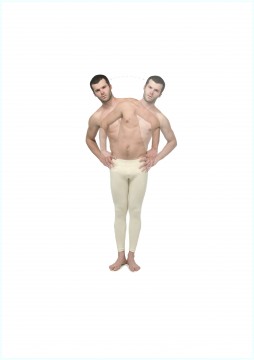
Jesse Aron Green, "Illustration and Description of the Medico-Gymnastic Exercises" (21/45; Bending of the body to the sides). 2008. Archival pigment print. 30x40 cm. Courtesy the artist.
OW: Do you see your practice as a form of historical investigation? Or does history enter your work more as background research that precedes the creative stage? I suppose I am asking how historical and artistic methods become intertwined in your work, if at all.
JAG: Instead of separating the two, I might propose that artistic work can be historical, especially as history must contend with the visual. This is to say that historical methods might be artistic methods when deployed within the field of art.
In another way, I might say that I engage with historical events, figures, and phenomena in order to grapple with the status of the referent; that is, to grapple with the way a historical marker can function according to its standard significations, its current understandings, as well as all of its associated contemporaneous entanglements. To continue with the example from before: when one points to structural film by making an artwork that adheres to its understood conventions, one not only makes a work that might be experienced in a way similar to that of the earlier works, one also engages all of the debates and theories that originally accompanied the practice of structural film in general. I suppose that some of my work attempts to make that engagement more explicit and more full.
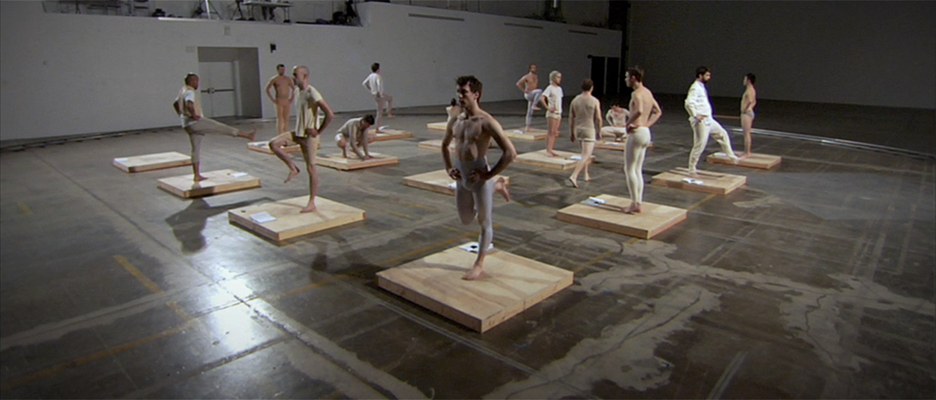
Jesse Aron Green, "Ärztliche Zimmergymnastik," 2008. High-definition video-installation (color, stereo sound). 80 minute loop. Dimensions variable (minimum projection size 18ʼ x 7.69ʼ, aspect ratio 2.34:1). Video still. Courtesy the artist.
OW: I think I hear what you’re saying. Would it make sense to distinguish between the illustration of a historical concept and the performance—or maybe the enactment—of that concept?
JAG: You’re grappling with the right verb to use—illustrate, enact, perform—all of these different ways of trying to capture what happens when one takes a pre-existing process and uses it, actions it. “Illustrate” clearly is not what one means, in the sense that it implies the reduction of a set of ideas to a literalized form. “Perform” implies a set of varying products that come out of a preexisting score or set of conventions, and so establishes a great distance between the poles of what should be interpenetrating ideas or forms. For me, the term with the most potential is “enact” or “enactment.” If one enacts something—and keep in mind that I do not mean reenact— one attempts to put into practice something that will allow for a coming into being, a coming into happening. It sounds very German, and perhaps rightly so. The idea of enactment has the potential to look back and find that which is important and useful from history and historical forms and practices, then relate them to a current context or moment. It is like a breathing into life. The key questions for me around enactment might sound too reduced, but they are (in light of enactment as political action): how can one do something? What does it mean to watch people do something, or attempt to do something?
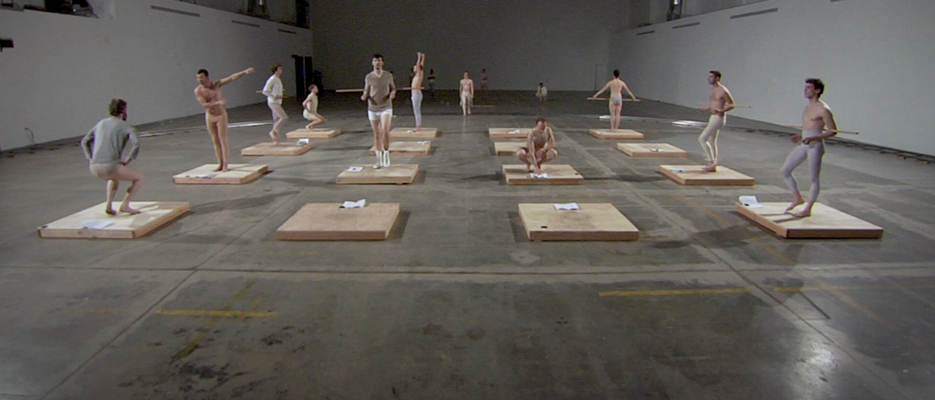
Jesse Aron Green, "Ärztliche Zimmergymnastik," 2008. High-definition video-installation (color, stereo sound). 80 minute loop. Dimensions variable (minimum projection size 18ʼ x 7.69ʼ, aspect ratio 2.34:1). Video still. Courtesy the artist.
OW: Switching gears: does the term “teaching artist” mean anything to you? I’ve always found it a strange designation, though I can’t quite pinpoint my reaction. Perhaps it suggests that teaching is some kind of condition, like pedagogy as pathology….
JAG: Artists-as-teachers exist to the degree they do because of the paucity of other options in the United States that do not seem either totally unrelated (day jobs), frustratingly proximate (gallery-sitting, installation work, and other ancillary positions within the arts), or instrumentalized (like artistic work as service provision within museum education departments, as Andrea Fraser has written about). It’s old hat to talk about the lack of governmental support for the arts, and how the university has attempted to fill that need (even if it is because art programs tend to bring in students and cash). Finally, it’s almost nothing but depressing to read something like the Rand report on the visual arts and learn that in 2005, the annual median income of people who consider themselves artists was about $700, with only 5% earning above $10,000 (especially when you consider that median production costs were twice the median income). Simply put, the attempt to be an artist, never mind a teaching artist, seems pathological, or at least totally foolish.
Regardless, I’m not sure what a career as an artist looks like, but I certainly know that working as a teacher and working as an artist are parallel careers. One can only attempt to clarify the difference between one’s practice and the services one provides, and the way these two overlap.
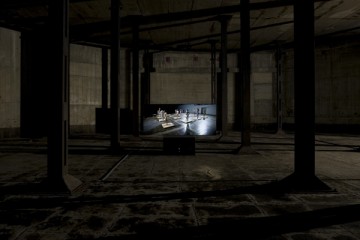
Jesse Aron Green, "Ärztliche Zimmergymnastik," 2008. High-definition video-installation (color, stereo sound). 80 minute loop. Dimensions variable (minimum projection size 18ʼ x 7.69ʼ, aspect ratio 2.34:1). Installation shot. Courtesy Tate Photography.
OW: I was particularly speaking about the phrase “teaching artist,” which always makes me shift in my seat. Maybe the gerund of teaching suggests that pedagogy is not a separate activity, but part of the person.
JAG: Teaching isn’t the uncomfortable word. It points to the root of the discomfort, which is the word ‘artist’; that is, the discomfort of attempting to claim oneself as an artist before one is a teacher. Certainly people do call themselves artists within the classroom, and I imagine that when they do it serves to reify a rather old-fashioned conception of the artist-as-expert. That is, naming oneself as such implies a subjective position of individuation, and often privilege. Within the profession of teaching, this position implies an expertise that often covers over a lack of pedagogical intent.
This is all to say: traces of the atelier system still exist, and I wish they would be more fully replaced by an alternative that integrated historical and theoretical considerations with the practice of making work. Neither am I interested in a scientificized field of art-study, in which the priorities of the humanities replace those of working artists, nor am I interested in theory or art history as that which props up contemporary practice, with little regard to their full understandings; I’m interested in a more informed, integrated approach.
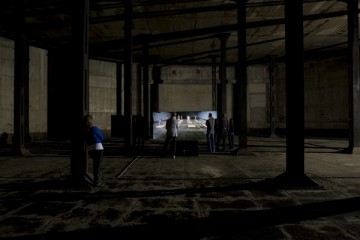
Jesse Aron Green, "Ärztliche Zimmergymnastik," 2008. High-definition video-installation (color, stereo sound). 80 minute loop. Dimensions variable (minimum projection size 18ʼ x 7.69ʼ, aspect ratio 2.34:1). Installation shot. Courtesy Tate Photography.
OW: You bring up the divide between theory and artistic practice, which returns us to where we started, to the question of interdisciplinarity. It sounds as if this more integrated approach that you call for might entail a kind of enactment. Can you elaborate?
JAG: I’m not sure I can, except by redirecting, again, to psychoanalysis. Insomuch as the field of art has focused on psychoanalytic theories, it may prove useful to look to an integration of its practice in its many forms, as messy and specific and contradictory and mysterious as they sometimes are. For example, the concepts of projection and introjection usefully explain how enactment might function; while a work that enacts in some way, according to the operation of these principles within actual therapeutic practice, might be exactly that which clarifies current issues of relationality, politics, and so on.
Perhaps the most reduced way of encapsulating this idea of enactment is to say that it is making as thinking, just as it is living as acting, with all of the political potential that such a likeness entails.




Pingback: The Overlooked are the Devises of Activity (Enactment) in Jesse Aron Green’s Ärztliche Zimmergymnastik by Erin Dziedzic « artcore journal